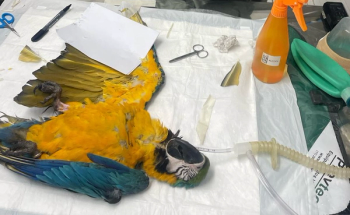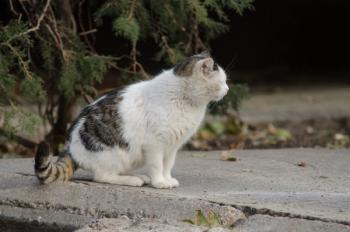
Feline infectious diarrhea update (Proceedings)
In shelters, there are many causes of diarrhea in felines. The predominant player that is of most significance is feline panleukopenia, but there are other pathogens that should not be overlooked when faced with an ill cat with diarrhea.
In shelters, there are many causes of diarrhea in felines. The predominant player that is of most significance is feline panleukopenia, but there are other pathogens that should not be overlooked when faced with an ill cat with diarrhea. A few of the most common culprits will be discussed in this lecture.
Coccidia
Clinical significance in a shelter
The prevalence of coccidia in cats ranges from 3% to 36% in North America. It is most commonly seen in young kittens where it can cause severe diarrhea, weight loss, dehydration, and even death. It is difficult to kill in the environment so it is important for kitten housing units and foster homes to be easy to disinfect.
Background information
Cats are the definitive hosts for Isospora felis and rivolta, protozoan parasites in the coccidian group. They are strictly host-specific.
Transmission
Infection occurs by ingesting a sporulated oocyst or by ingesting the tissues of an intermediary host such as a rodent. Infection can also occur by ingesting sporulated oocysts carried by insects such as flies or cockroaches. Unsporulated oocysts are passed in the feces of infected cats 5 to 10 days after initial infection. Sporulation can occur after 12 hours in the environment.
Clinical signs
Disease tends to be limited to kittens where vomiting, watery diarrhea, anorexia, weight loss, and death can occur. Subclinical kittens can continue to shed oocysts into the environment.
Diagnosis
Oocysts can be easily recognized on a fecal float but because they can be shed by normal animals as well as clinically ill animals, a positive diagnosis does not necessarily rule out other causes of diarrhea in sick animals.
Treatment
In healthy animals, disease is thought to be self-limiting. In shelter settings, however, it is beneficial to treat animals to minimize environmental contamination. Sulfadimethoxine is the most commonly prescribed drug but it is not the most effective in a shelter setting. Ponazuril is preferred because of its activity as a coccidiocidal (as opposed to coccidiostatic) drug that only requires one to two doses
Prevention
Isospora oocysts are difficult to kill in the environment. Most disinfectants do not kill them so isolation of animals known to be shedding large quantities is important. Kittens should be housed in areas that can be easily cleaned without carpeted furniture or upholstery. Feces should be picked up promptly so that oocysts have less likelihood of sporulating.
Giardia
Clinical significance in a shelter
The prevalence of giardia in cats ranges normally from 1 to 10% but higher percentages have been reported in catteries and animal shelters. The majority of cats with giardia are clinically normal, so if a cat with diarrhea is diagnosed with giardia, it is important to rule out concurrent illness with other pathogens.
While we often think of giardia as potentially zoonotic, there is little evidence of zoonotic transmission from cats to humans and its role as a zoonotic potential has yet to be examined
Background information
Giardia is a protozoal organism that exists in two forms, trophozoite and cyst. There are six species of Giardia with Giardia lamblia (duodenalis, intestina-lis) the most common in cats. This species is further differentiated into six assemblages that are predominantly restricted to the species the organism affects. Assemblages A and F have both been detected in cats, with A being a potentially zoonotic assemblage
Transmission
Giardia is transmissible in the cyst form via the fecal-oral route or from fomites that can live for months in cool, moist environments, making disinfection of the shelter environment important for control. The prepatent period lasts from 5 to 16 days.
Clinical signs
Most positive shelter cats are clinically normal. When clinical disease is present, Giardia generally causes acute small bowel diarrhea. Diarrhea can be fatty and malodorous and is most commonly seen in kittens. Blood and mucous are uncommon. Clinical signs can appear 1 to 2 days before cysts are present in feces.
Diagnosis
Cysts detection using the zinc sulfate centrifugation floatation test (ZNCT) is considered the gold standard by many, but in a shelter setting, the in-house antigen SNAP giardia test (IDEXX laboratories) is more practical. Since cysts can be shed intermittently and are often in low numbers, multiple ZNCT fecal floats are required to rule out Giardia. The antigen assay, in comparison, targets antigen from trophozoites that are continuously shed, making it less prone to false negatives due to low numbers. Trophozoites can be detected directly by wet mount or fecal float as well, but are often difficult to catch on quick scan and can be easily confused with Tritrichomonas foetus trophozoites. Once a positive test is obtained, it is important to recognize that it does not necessarily indicate that Giardia is the cause of clinical disease. Other concurrent pathogens should also be ruled out in the event of disease.
Treatment
Cats that are positive for giardia but do not have clinical disease should not be treated solely for the purpose of preventing zoonotic transmissionMetronidazole or fenbendazole are the most commonly used effective treatment in shelter settings for cats and may be used together or separately. A feline vaccine exists but does not appear to consistently reduce disease and is not a recommended option in a shelter setting.
Prevention
It is important to keep the shelter environment clean and dry, since giardia cysts thrive in moist environments. Most common cleaning agents used in shelters including quaternary ammonium compounds will kill giardia effectively. Clinically ill animals shed more cysts than subclinical animals so it is important to isolate animals that are showing clinical signs.
Tritrichomonas foetus
Clinical significance in shelters
T. foetus is a flagellated, protozoal parasite of the gastrointestinal tract of felines. It can result in large bowel diarrhea in cats living in high-density catteries and animal sheltersThe prevalence of T. foetus in purebred cats in catteries has been reported as 31% in one study in the United States, but this varies considerably with studies from other countries where numbers as low as 0% prevalence have been reported in shelter cats. The prevalence of T. foetus in shelters in the United States has not been reported.
Transmission
Trichomonads are transmitted vertically in cats in close contact and through the fecal-oral route from shared litter boxes. Because there is no cyst form, T. foetus has been thought to primarily infect cats via close contact. More recent studies demonstrate that it can be infective for at least 6 hours from fecal samples of shedding cats and can last in moist environments up to 3 days.
Clinical Signs
T. foetus produces large bowel diarrhea, with accompanying blood, mucus, tenesmus, and occasionally rectal prolapse. Many infected older cats do not show clinical signs but should be considered asymptomatic carriers.
Diagnosis
T. foetus can be diagnosed via fecal culture, PCR, or direct fecal smear using fresh feces and saline mount.
Treatment
Diarrhea will spontaneously resolve in the majority of cats but this can take extended periods of time during which they may still shed into the environment. Metronidazole has not been an effective treatment option for T. foetus. Ronidazole is the therapy that is most effective, but side effects, reasonably long treatment course, and costs may not make it an effective option for shelters.
Prevention
Reduction of overcrowding will be the single most important way to manage T. foetus infections in a shelter setting. Eradication via treatment is not a viable option in shelters. At this time, it is still unknown what role this pathogen plays in shelter settings.
References
Hurley book Table 15.3
Ghanem, M. M., M. E. Radwaan, et al. (2008). "Comparative therapeutic effect of toltrazuril, sulphadimidine and amprolium on Eimeria bovis and Eimeria zuernii given at different times following infection in buffalo calves (Bubalus bubalis)." Preventive veterinary medicine 84(1-2): 161-170.
Lloyd, S. and J. Smith (2001). "Activity of toltrazuril and diclazuril against Isospora species in kittens and puppies." Vet Rec 148(16): 509-511.
Daugschies, A., H. C. Mundt, et al. (2000). "Toltrazuril treatment of cystoisosporosis in dogs under experimental and field conditions." Parasitology research 86(10): 797-799.
Kirkpatrick, C. E. and J. P. Laczak (1985). "Giardiasis in a cattery." J Am Vet Med Assoc 187(2): 161-162.
Spain, C. V., J. M. Scarlett, et al. (2001). "Prevalence of enteric zoonotic agents in cats less than 1 year old in central New York State." J Vet Intern Med 15(1): 33-38.
Janeczko, S. and B. Griffin (2010). "Giardia infection in cats." Compendium 32(8): E1-7.
Thompson, R. C., C. S. Palmer, et al. (2008). "The public health and clinical significance of Giardia and Cryptosporidium in domestic animals." Veterinary journal 177(1): 18-25.
Vasilopulos, R. J., L. G. Rickard, et al. (2007). "Genotypic analysis of Giardia duodenalis in domestic cats." Journal of veterinary internal medicine / American College of Veterinary Internal Medicine 21(2): 352-355.
Sprong, H., S. M. Caccio, et al. (2009). "Identification of zoonotic genotypes of Giardia duodenalis." PLoS neglected tropical diseases 3(12): e558.
Janeczko, S. and B. Griffin (2010). "Giardia infection in cats." Compendium 32(8): E1-7.
Stein, J. E., S. V. Radecki, et al. (2003). "Efficacy of Giardia vaccination in the treatment of giardiasis in cats." Journal of the American Veterinary Medical Association 222(11): 1548-1551.
Tolbert, M. K. and J. Gookin (2009). "Tritrichomonas foetus: A New Agent of Feline Diarrhea." Compendium 31(8): 374-381.
Gookin, J. L., E. B. Breitschwerdt, et al. (1999). "Diarrhea associated with trichomonosis in cats." J Am Vet Med Assoc 215(10): 1450-1454.
Gookin, J. L., M. E. Stebbins, et al. (2004). "Prevalence of and risk factors for feline Tritrichomonas foetus and giardia infection." Journal of clinical microbiology 42(6): 2707-2710.
Bissett, S. A., M. L. Stone, et al. (2009). "Observed occurrence of Tritrichomonas foetus and other enteric parasites in Australian cattery and shelter cats." Journal of feline medicine and surgery 11(10): 803-807.
Hale, S., J. M. Norris, et al. (2009). "Prolonged resilience of Tritrichomonas foetus in cat faeces at ambient temperature." Veterinary parasitology 166(1-2): 60-65.
Levy, M. G., J. L. Gookin, et al. (2003). "Tritrichomonas foetus and not Pentatrichomonas hominis is the etiologic agent of feline trichomonal diarrhea." The Journal of parasitology 89(1): 99-104.
Hurley Chapter 15
Gray, S. G., S. A. Hunter, et al. (2010). "Assessment of reproductive tract disease in cats at risk for Tritrichomonas foetus infection." American journal of veterinary research 71(1): 76-81.
Kather, E. J., S. L. Marks, et al. (2007). "Determination of the in vitro susceptibility of feline tritrichomonas foetus to 5 antimicrobial agents." Journal of veterinary internal medicine / American College of Veterinary Internal Medicine 21(5): 966-970.
Gookin, J. L., C. Copple, et al. (2005). Efficacy of Ronidazole in vitro and in vivo for Treatment of Feline Tritrichomonas foetus Infection. ACVIM.
Rosado, T. W., A. Specht, et al. (2007). "Neurotoxicosis in 4 cats receiving ronidazole." Journal of veterinary internal medicine / American College of Veterinary Internal Medicine 21(2): 328-331.
Newsletter
From exam room tips to practice management insights, get trusted veterinary news delivered straight to your inbox—subscribe to dvm360.






